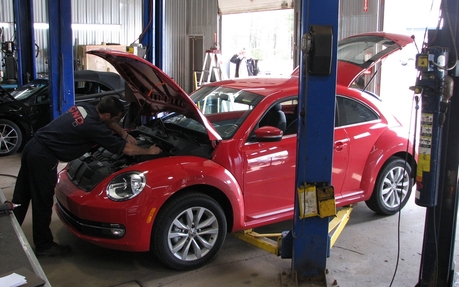The 2012 Beetle Gets a Physical
The Volkswagen Beetle was remodeled in 2012 and since then it has proudly sported a stockier, more virile and more athletic physique. There’s no question that Volkswagen is pursuing male buyers with these changes. Seen from the side, the roofline is distinctly less curved than it was in the past. Plus, the headlamps and tail lights look a little like those on Porsche models. But despite these physical modifications, the mechanical components are essentially unchanged compared to last year. To get the full picture on this bug, we headed to Nicolas Demers’ garage in Saint-Étienne-de-Lauzon, Quebec.
Nice execution
Our mechanic decided to start the exam by going directly under the hood. We immediately noted that the Beetle’s five-cylinder engine takes up a good chunk of the engine compartment. It’s hidden under an immense plastic cover, which proved fairly easy to remove after unscrewing a few nuts. On the back of the plastic cover is the air filter housed in a plastic case. This ingenious decision maximizes space within the compartment, but as our mechanic pointed out, you have no choice but to remove the cover to access the air filter, even if you just want to check its condition. You might call it unnecessary effort. That said, if you have the filter changed at the dealership on a regular basis, you don’t really need to worry about checking on it. Also, there are no spark plugs, as these have been replaced by solenoids. Overall, the mechanical components are well positioned and presented, and the quality of materials is excellent. The most vulnerable pipes and wires most are protected by metal sheaths to prevent them from overheating and wearing out prematurely. Even the battery comes in a padded case to protect it from extreme temperatures.
Less plastic
We were surprised to find a lack of plastic covers protecting the mechanical parts under the vehicle. Volkswagen usually outfits the bottom of their vehicles with numerous plastic covers to protect parts from weather and to improve air flow for a better drag coefficient and fuel economy. On the 2012 Beetle, however, there’s just one cover under the powertrain.
Our quick inspection allowed us to ascertain that the exhaust system is made of sizeable steel parts and is solidly held in place by large attachment pieces. In general, the parts seen under the vehicle are above average. The floor is nearly flat with nothing sticking out. An anti-rust treatment has been applied but does not cover all of the chassis.
The suspension is traditional. The upper part of the front strut suspension tilts slightly backward to better take and absorb shock. This configuration is common on German vehicles, such as Audis and BMWs, as it results in more solid road handling. The rear torsion beam suspension is simple but efficient in its design and should be easy to maintain. All parts are well affixed with good-size connectors. The only part that came up short in manufacturing quality was the hand-brake cable, as it connects directly to the brake caliper. This results in less powerful braking and leaves it vulnerable to rust.
In sum, this Beetle upholds Volkswagen’s reputation for solidity and quality. This in turn translates into exemplary road handing and a sense of safety aboard the vehicle.
